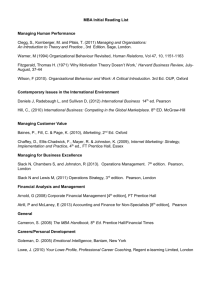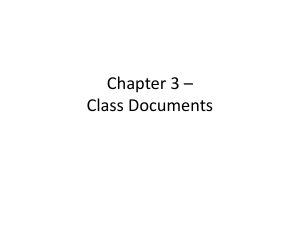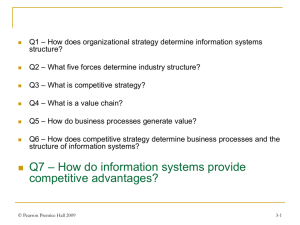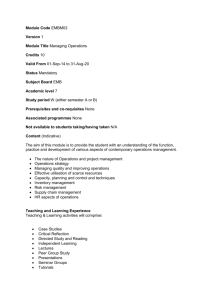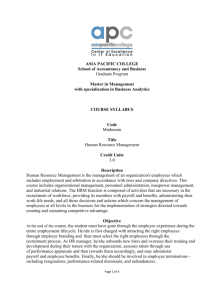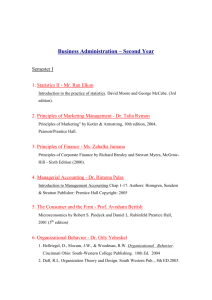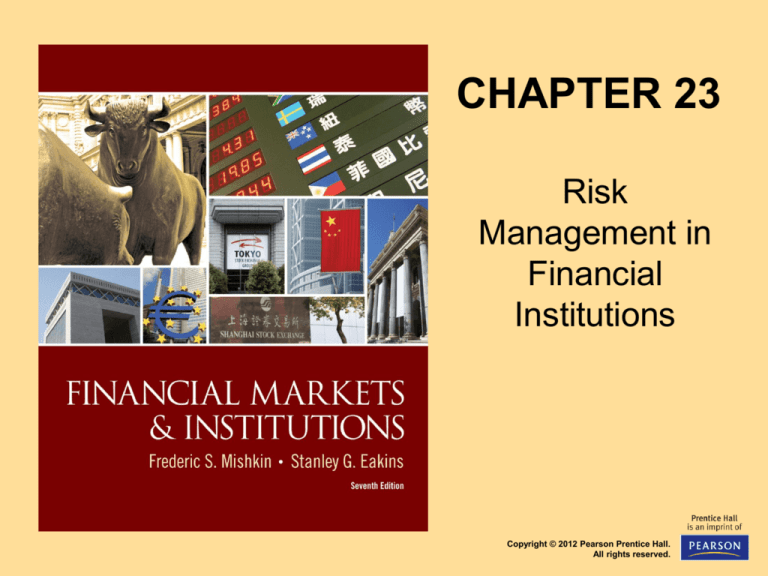
CHAPTER 23
Risk
Management in
Financial
Institutions
Copyright © 2012 Pearson Prentice Hall.
All rights reserved.
Chapter Preview
We examine how financial institutions
manage credit risk, default risk, etc. We
explore the tools available to managers to
measure these risks and strategies to
reduce them. Topics include:
─ Managing Credit Risk
─ Managing Interest-Rate Risk
© 2012 Pearson Prentice Hall. All rights reserved.
23-1
Managing Credit Risk
A major part of the business of financial
institutions is making loans, and the major
risk with loans is that the borrow will
not repay.
Credit risk is the risk that a borrower will
not repay a loan according to the terms of
the loan, either defaulting entirely or making
late payments of interest or principal.
© 2012 Pearson Prentice Hall. All rights reserved.
23-2
Managing Credit Risk
Once again, the concepts of adverse
selection and moral hazard will provide
our framework to understand the principles
financial managers must follow to minimize
credit risk, yet make successful loans.
© 2012 Pearson Prentice Hall. All rights reserved.
23-3
Managing Credit Risk
Solving Asymmetric Information Problems:
1. Screening and Monitoring:
─ collecting reliable information about prospective
borrowers. This has also lead some institutions
to specialize in regions or industries, gaining
expertise in evaluating particular firms
─ also involves requiring certain actions, or
prohibiting others, and then periodically
verifying that the borrower is complying with the
terms of the loan contract.
© 2012 Pearson Prentice Hall. All rights reserved.
23-4
Managing Credit Risk
Specialization in Lending helps in
screening. It is easier to collect data on
local firms and firms in specific industries. It
allows them to better predict problems by
having better industry and location
knowledge.
© 2012 Pearson Prentice Hall. All rights reserved.
23-5
Managing Credit Risk
Monitoring and Enforcement also helps.
Financial institutions write protective
covenants into loans contracts and actively
manage them to ensure that borrowers are
not taking risks at their expense.
© 2012 Pearson Prentice Hall. All rights reserved.
23-6
Managing Credit Risk
2. Long-term Customer Relationships:
past information contained in checking
accounts, savings accounts, and previous
loans provides valuable information to
more easily determine credit worthiness.
© 2012 Pearson Prentice Hall. All rights reserved.
23-7
Managing Credit Risk
3. Loan Commitments: arrangements
where the bank agrees to provide a loan
up to a fixed amount, whenever the firm
requests the loan.
4. Collateral: a pledge of property or other
assets that must be surrendered if the
terms of the loan are not met ( the loans
are called secured loans).
© 2012 Pearson Prentice Hall. All rights reserved.
23-8
Managing Credit Risk
5. Compensating Balances: reserves that a
borrower must maintain in an account that
act as collateral should the borrower default.
6. Credit Rationing:
lenders will refuse to lend to some borrowers,
regardless of how much interest they are willing to pay,
or
lenders will only finance part of a project, requiring that
the remaining part come from equity financing.
© 2012 Pearson Prentice Hall. All rights reserved.
23-9
Managing Interest-Rate Risk
Financial institutions, banks in particular,
specialize in earning a higher rate of return
on their assets relative to the interest paid
on their liabilities.
As interest rate volatility increased in the
last 20 years, interest-rate risk exposure
has become a concern for financial
institutions.
© 2012 Pearson Prentice Hall. All rights reserved.
23-10
Managing Interest-Rate Risk
To see how financial institutions can
measure and manage interest-rate risk
exposure, we will examine the balance
sheet for First National Bank (next slide).
We will develop two tools, (1) Income Gap
Analysis and (2) Duration Gap Analysis, to
assist the financial manager in this effort.
© 2012 Pearson Prentice Hall. All rights reserved.
23-11
Managing Interest-Rate Risk
Risk Management Association home page http://www.rmahq.org
© 2012 Pearson Prentice Hall. All rights reserved.
23-12
Income Gap Analysis: Determining Rate
Sensitive Items for First National Bank
Assets
─ assets with maturity
less than one year
─ variable-rate mortgages
─ short-term commercial
loans
─ portion of fixed-rate
mortgages (say 20%)
© 2012 Pearson Prentice Hall. All rights reserved.
Liabilities
─
─
─
─
─
─
money market deposits
variable-rate CDs
short-term CDs
federal funds
short-term borrowings
portion of checkable
deposits (10%)
─ portion of savings (20%)
23-13
Income Gap Analysis: Determining Rate
Sensitive Items for First National Bank
Rate-Sensitive Assets
= $5m + $ 10m + $15m + 20% $20m
RSA = $32m
Rate-Sensitive Liabs
= $5m + $25m + $5m + $10m + 10% $15m
+ 20% $15m
RSL = $49.5m
if i 5%
Asset Income
Liability Costs
Income
= +5% $32.0m
= +5% $49.5m
= $1.6m $ 2.5
© 2012 Pearson Prentice Hall. All rights reserved.
= +$ 1.6m
= +$ 2.5m
= $ 0.9m
Estimate of % of checkable
deposits and savings
accounts that will
experience rate change
23-14
Income Gap Analysis
If RSL > RSA, i results in: NIM , Income
GAP = RSA RSL
= $32.0m $49.5m = $17.5m
Income = GAP i
= $17.5m 5% = $0.9m
This is essentially a short-term focus on interest-rate risk
exposure. A longer-term focus uses duration gap analysis.
© 2012 Pearson Prentice Hall. All rights reserved.
23-15
Duration Gap Analysis
Owners and managers do care about the
impact of interest rate exposure on current
net income.
They are also interested in the impact of
interest rate changes on the market value
of balance sheet items and on net worth.
The concept of duration, which first
appeared in chapter 3, plays a role here.
© 2012 Pearson Prentice Hall. All rights reserved.
23-16
Duration Gap Analysis
Duration Gap Analysis: measures the
sensitivity of a bank’s current year net
income to changes in interest rate.
Requires determining the duration for assets
and liabilities, items whose market value will
change as interest rates change. Let’s see
how this looks for First National Bank.
© 2012 Pearson Prentice Hall. All rights reserved.
23-17
Duration of First
National Bank's
Assets and
Liabilities
Duration Gap Analysis
The basic equation for determining the change in
market value for assets or liabilities is:
or:
© 2012 Pearson Prentice Hall. All rights reserved.
23-19
Duration Gap Analysis
Consider a change in rates from 10% to
11%. Using the value from Table 23.1,
we see:
Assets:
© 2012 Pearson Prentice Hall. All rights reserved.
23-20
Duration Gap Analysis
Liabilities:
Net Worth:
© 2012 Pearson Prentice Hall. All rights reserved.
23-21
Duration Gap Analysis
For a rate change from 10% to 11%, the net
worth of First National Bank will fall,
changing by $1.6m.
Recall from the balance sheet that First
National Bank has “Bank capital” totaling
$5m. Following such a dramatic change in
rate, the capital would fall to $3.4m.
© 2012 Pearson Prentice Hall. All rights reserved.
23-22
Managing Interest-Rate Risk
Strategies for Managing Interest-Rate Risk
─ In example above, shorten duration of bank
assets or lengthen duration of bank liabilities
─ To completely immunize net worth from
interest-rate risk, set DURgap = 0
© 2012 Pearson Prentice Hall. All rights reserved.
23-23
Managing Interest-Rate Risk
Problems with GAP Analysis
─ Assumes slope of yield curve unchanged
and flat, but
http://stockcharts.com/charts/YieldCurve.html
─ Manager estimates % of fixed rate assets and
liabilities that are rate sensitive
© 2012 Pearson Prentice Hall. All rights reserved.
23-24
Chapter Summary
Managing Credit Risk: basic techniques for
managing relationships and rationing credit
were reviewed.
Managing Interest-Rate Risk: the essential
techniques of measuring interest-rate risk
for both income and capital affects were
presented.
© 2012 Pearson Prentice Hall. All rights reserved.
23-25

